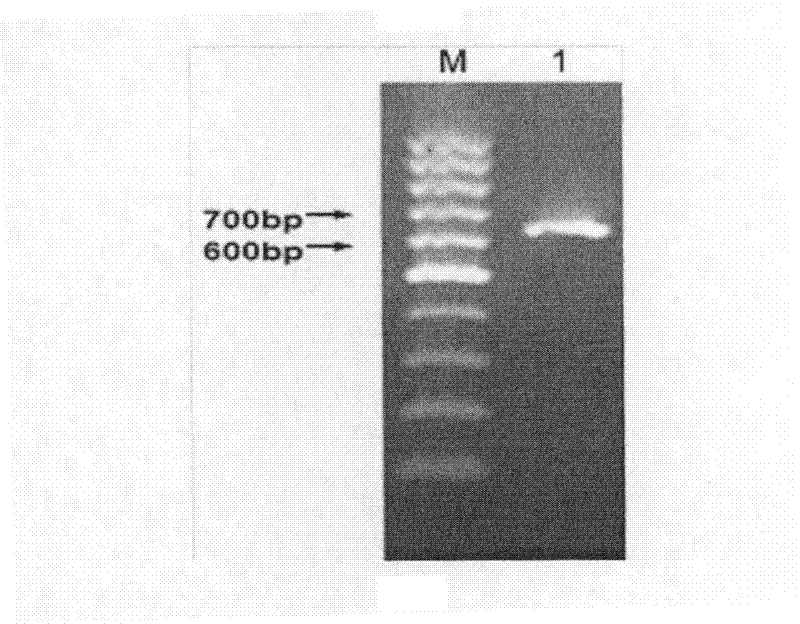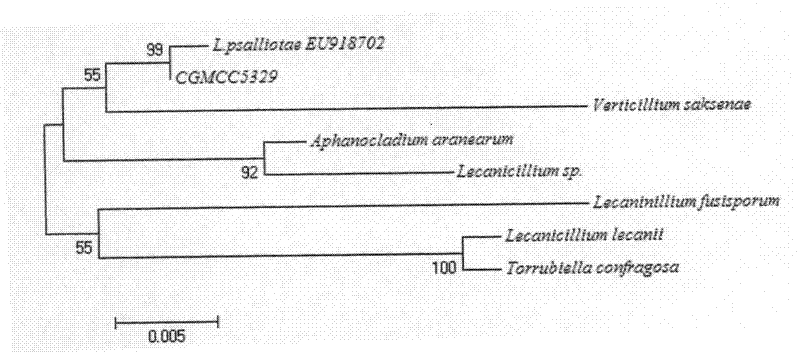Lecanicillium psalliotae strain
A technology of Lecanococcus spp. and bacterial strains, applied in the direction of fungi, biocides, plant growth regulators, etc., can solve the problems of lack of anti-root-knot nematodes, no safe and effective control of root-knot nematodes, etc., and achieve efficient production of several Efficacy of tetratinase, large application potential, high enzyme activity
- Summary
- Abstract
- Description
- Claims
- Application Information
AI Technical Summary
Problems solved by technology
Method used
Image
Examples
Embodiment 1
[0034] Embodiment 1. Isolation of the lecanococcus bacterial strain of the present invention
[0035] (1) Culture medium: use water agar medium (WA), heat to dissolve, cool to about 45°C, add streptomycin (0.1mg / ml), shake well and pour into a 9cm diameter petri dish for use.
[0036] (2) Separation method: wash the loofah roots collected from Chengyang District, Qingdao City infected with root-knot nematode with water to remove sediment, pick fresh egg masses under a Nikon SMZ1000 dissecting microscope, shake and dissociate in 2% NaClO, and dissolve them at 500 Collect the eggs on a mesh sieve, and then sterilize the surface with 2% NaClO, then spread the egg suspension on the prepared WA medium, each dish contains about 50 eggs, and then put the culture dish in a constant temperature incubator at 27°C Cultivate, observe regularly, pick the grown hyphae to PDA medium, and store them at 4°C after the mycelium grows to be observed and identified later.
Embodiment 2
[0037] Embodiment 2. The bacterial colony character cultivation and the morphological identification of the lecanococcus spp. strain of the present invention
[0038] (1) Cultivation of colony traits: Transfer the strains stored in the refrigerator at 4°C to a PDA plate with a diameter of 9 cm, activate at 27°C for 5 days, use a puncher with a diameter of 6 mm to cut off the bacterial block at the edge of the colony, and transfer to a new PDA Plates were cultured in the dark at 27°C and repeated 3 times. From the 2nd day, the colony shape, color and colony growth were recorded until the colonies covered the plate. The colony of Lecanococcus cerevisiae grows quickly, and its diameter is 56-61 mm in PDA medium for 10 days, and it is white cotton-like when viewed from the front (see figure 1 G), the back of the colony is red or purple, and the pigment can be produced in 3-5 days, and the red or pink pigment often diffuses into the agar (see figure 1 h).
[0039] (2) Morphologi...
Embodiment 3
[0041] Example 3. Molecular biology identification, rDNA-ITS sequence alignment and phylogenetic analysis of the present invention's Lecanococcus cerevisiae strain
[0042] (1) Synthesis of amplification primers: synthesized by Shanghai Sangon Bioengineering Technology Service Co., Ltd.
[0043] Universal PCR amplification primers:
[0044] ITS1-F: 5'-CTTGGTCATTTAGAGGAAGT-3'
[0045] ITS4-R: 5'-CCTCCGCTTATTGATATGC-3'
[0046] (2) Extraction of genomic DNA: the DNA of Lecanococcus cerevisiae was extracted by CTAB method;
[0047] (3) PCR reaction system (20 μl): template DNA 1 μl, PCR Master Mix (Thermo Fisher Scientific) 10 μl, upstream and downstream primers 1 μl each, supplemented with deionized water to 20 μl. Reaction conditions: pre-denaturation at 94°C for 4min; 35 cycles at 94°C for 1min, 30s at 55°C, and 90s at 72°C; extension at 72°C for 10min.
[0048] (4) Gene sequencing of Lecanococcus spp.: The PCR product was detected by 1% agarose gel electrophoresis, and th...
PUM
 Login to View More
Login to View More Abstract
Description
Claims
Application Information
 Login to View More
Login to View More - R&D
- Intellectual Property
- Life Sciences
- Materials
- Tech Scout
- Unparalleled Data Quality
- Higher Quality Content
- 60% Fewer Hallucinations
Browse by: Latest US Patents, China's latest patents, Technical Efficacy Thesaurus, Application Domain, Technology Topic, Popular Technical Reports.
© 2025 PatSnap. All rights reserved.Legal|Privacy policy|Modern Slavery Act Transparency Statement|Sitemap|About US| Contact US: help@patsnap.com



